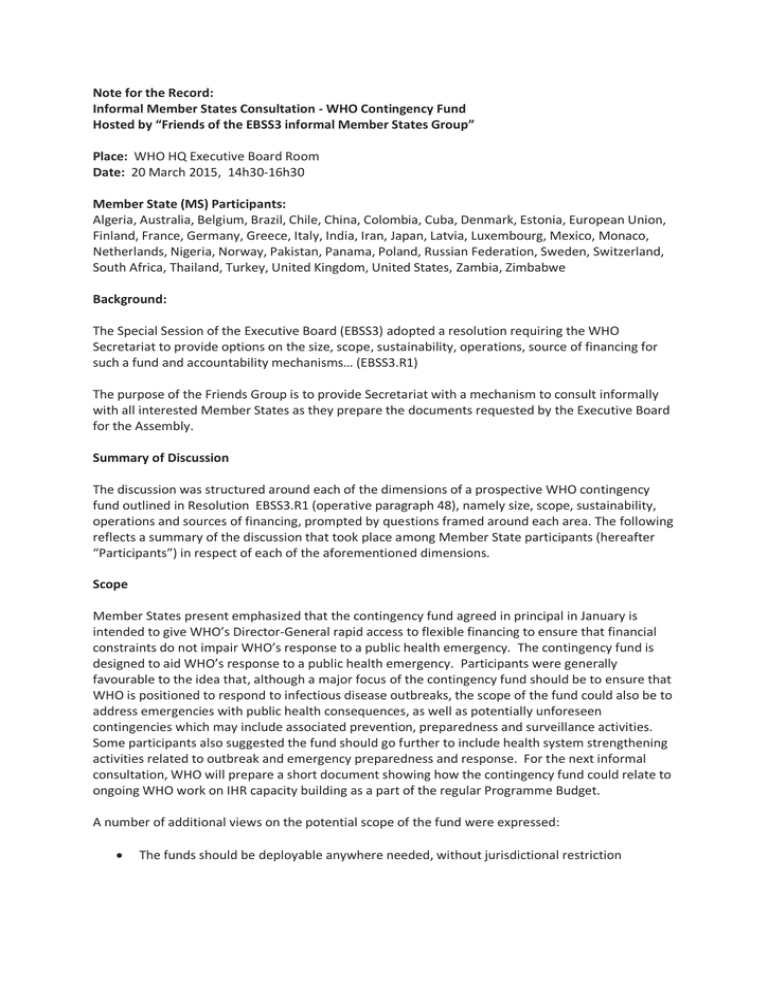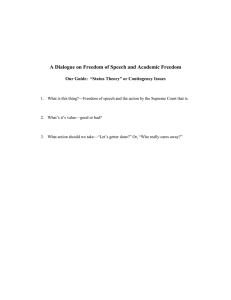Note for the Record - World Health Organization
advertisement

Note for the Record: Informal Member States Consultation - WHO Contingency Fund Hosted by “Friends of the EBSS3 informal Member States Group” Place: WHO HQ Executive Board Room Date: 20 March 2015, 14h30-16h30 Member State (MS) Participants: Algeria, Australia, Belgium, Brazil, Chile, China, Colombia, Cuba, Denmark, Estonia, European Union, Finland, France, Germany, Greece, Italy, India, Iran, Japan, Latvia, Luxembourg, Mexico, Monaco, Netherlands, Nigeria, Norway, Pakistan, Panama, Poland, Russian Federation, Sweden, Switzerland, South Africa, Thailand, Turkey, United Kingdom, United States, Zambia, Zimbabwe Background: The Special Session of the Executive Board (EBSS3) adopted a resolution requiring the WHO Secretariat to provide options on the size, scope, sustainability, operations, source of financing for such a fund and accountability mechanisms… (EBSS3.R1) The purpose of the Friends Group is to provide Secretariat with a mechanism to consult informally with all interested Member States as they prepare the documents requested by the Executive Board for the Assembly. Summary of Discussion The discussion was structured around each of the dimensions of a prospective WHO contingency fund outlined in Resolution EBSS3.R1 (operative paragraph 48), namely size, scope, sustainability, operations and sources of financing, prompted by questions framed around each area. The following reflects a summary of the discussion that took place among Member State participants (hereafter “Participants”) in respect of each of the aforementioned dimensions. Scope Member States present emphasized that the contingency fund agreed in principal in January is intended to give WHO’s Director-General rapid access to flexible financing to ensure that financial constraints do not impair WHO’s response to a public health emergency. The contingency fund is designed to aid WHO’s response to a public health emergency. Participants were generally favourable to the idea that, although a major focus of the contingency fund should be to ensure that WHO is positioned to respond to infectious disease outbreaks, the scope of the fund could also be to address emergencies with public health consequences, as well as potentially unforeseen contingencies which may include associated prevention, preparedness and surveillance activities. Some participants also suggested the fund should go further to include health system strengthening activities related to outbreak and emergency preparedness and response. For the next informal consultation, WHO will prepare a short document showing how the contingency fund could relate to ongoing WHO work on IHR capacity building as a part of the regular Programme Budget. A number of additional views on the potential scope of the fund were expressed: The funds should be deployable anywhere needed, without jurisdictional restriction The contingency fund should complement existing emergency mechanisms like OCHA CERF and linkages to different mechanisms, including at regional level, need to be clearly spelled out. Financing the strengthening of IHR core capacities was viewed as a potential role for the fund Coherence is needed between the contingency fund and other elements of WHO’s emergency reforms, including the prospective Global Emergency Health Workforce, as well as WHO’s existing programmes, particularly health systems strengthening and infectious disease control programmes Recognizing that unforeseen emergencies may warrant different types of responses from WHO, and therefore there is a need for greatest possible flexibility on the scope and use of the fund, some views were expressed on potential limitations on the scope of the fund: The contingency fund should not be used for large-scale procurement or stockpiling as there are exist other mechanisms to achieve this The fund should not be used to finance existing programmes that have well established alternative sources of financing (e.g.: Global Fund to Fight AIDS, TB and Malaria and the Polio Eradication Initiative). Longer-term prevention and health system development for preparedness could be financed by alternative mechanisms like the World Bank Pandemic Emergency Facility that is currently under discussion Operations In view of the need for a rapid response financing mechanism, Participants generally favoured delegation of disbursement decisions to the Director-General, and governance/oversight of the fund through WHO’s existing governing body mechanisms. It was noted that the operationalizing the fund should be a streamlined process with speed of use as a paramount objective. Clear and well defined trigger mechanisms were highlighted in this regard. In terms of operationalizing the fund, different potential triggers and their implications need to be further explored. Participants noted that a declaration of a Public Health Emergency of International Concern (PHEIC) may be too late of a trigger for the fund as a principle objective of the fund should be to prevent the escalation of an event before it becomes a major emergency. The IHRs were noted as a potential framework that could still provide guidance on triggers prior to a PHEIC designation, but their limits as currently implemented were also noted. Participants also suggested a number of other potential trigger mechanism options for further analysis, including: a request from government for WHO support to address an emergency event; a WHO risk assessment of an emergency event; or use of WHO’s Emergency Response Framework. Sources of Financing and Sustainability Participants noted that a number of different options related to sources of financing need to be examined, and that it is important to study other funding mechanisms to learn from existing practices. Participants emphasized the need for predictability and adequacy (volume) of financing as key principles when exploring different sources, in addition to rapid access to, and sustainability of, funding. It was highlighted that, at this stage, the strengths and weaknesses of all potential sourcing options should be reviewed against these principles. Participants noted that a blend of increased assessed contributions (whether assessed separately or provided from a portion of current assessments) to provide sustainable and predictable financing flows, complemented by additional voluntary contributions to achieve requisite amount of funding, should also be explored as one potential sourcing and sustainability option. A number of questions were raised which will require further discussion for instance how the Emergency Funds in the regions would relate to this contingency fund. In addition, several delegations considered that contributions beyond Member State financing (either AC or VC) should be explored. The importance of a clear and compelling communication strategy focused on the impact and lives saved through such a fund was emphasized across delegations. The Global Fund to Fight HIV/AIDS, Tuberculosis, and Malaria was considered a particularly effective example in this regard as a way to motivate donors. Delegations briefly touched on options around replenishment models and how the proposed fund would link to the regular WHO Programme Budget cycle , but considered that we needed more concrete information and detail around other aspects of the fund before this element of sustainability could be explored further. Accountability mechanisms Participants emphasized the need for oversight by WHO’s governing bodies over the use and financing of the contingency fund. Secretariat Action (next steps) Participants suggested that it would be useful for Member States if Secretariat could do the following as they proceed with drafting and in preparation for the next informal meeting: Provide Member States with details of existing mechanisms and those currently being discussed, outlining how WHO’s contingency fund would complement these. Provide examples of WHO Regional funds and other UN emergency funds in terms of scope, triggers, governance, size, sources of funds, and operations. Provide options on different dimensions of the potential scope of the fund. Provide Member States with an overview of most recent emergency financial requirements for grade 2 and grade 3 emergencies as well as to use the starting point from the 2011 IHR review committee - $100 million fund – to estimate what Member States could achieve at that level of financing. Provide MS with a list of pros and cons of different options for financing, housing and governance ofWHO’s contingency fund.
